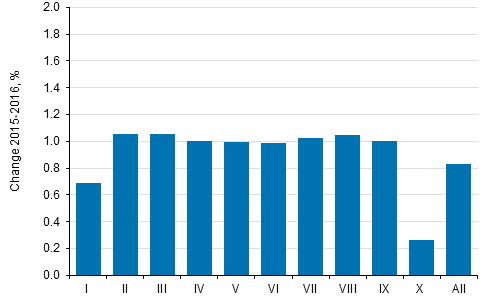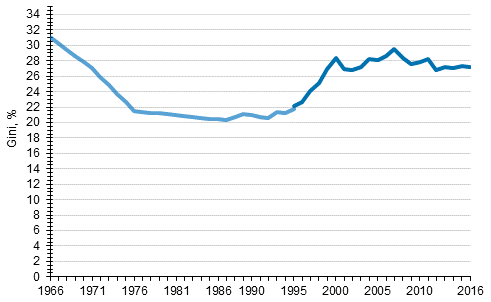This set of statistics has been discontinued.
Statistical data on this topic are published in connection with another set of statistics.
Data published after 5 April 2022 can be found on the renewed website.
Published: 20 December 2017
Income differentials stayed nearly unchanged in 2016
Statistics Finland's total statistics on income distribution show that income differentials stayed almost unchanged in 2016 compared with the previous year. Real income increased in all income deciles, but more for those with medium income than for those with high and low income. The average income of the lowest-income decile grew in real terms by 0.7 per cent and that of the highest-income decile by 0.3 per cent from 2015 to 2016. In other income deciles, the income level grew evenly by around one per cent.
Change in average real income (%) by income decile from 2015 to 2016

Income decile: the population is arranged according to income and divided into ten equal parts, each of which has around half a million persons. The first (I) income decile is the lowest-income decile and the tenth (X) is the highest-income decile. Income concept: equivalent disposable monetary income (incl. realised capital gains) of household dwelling-unit, average per person. Equivalent income: the household-dwelling unit’s income divided by its consumption units (modified OECD-scale).
During the 50-year period covered by the Income distribution statistics, income differentials are currently on level with the turn of the millennium and the early 1970s. The relative income differentials were at their lowest in the mid-1980s. In 2016, the Gini coefficient received the value 27.2, which was 0.1 percentage points lower than in the year before. Compared with 1995, the Gini coefficient has grown by around five percentage points, most of which is caused by income differentials growing fast in the late 1990s. The Gini coefficient gets the value 0 if everyone receives the same amount of income and 100 if one income earner receives all the income. The higher the Gini coefficient, the higher the income differentials are.
Development of income inequality 1966–2016, Gini coefficient (%)

Persons belonging to the household-dwelling population, the household-dwelling unit's equivalent disposable monetary income (incl. realised capital gains). Sources: 1995 to 2016 Total statistics on income distribution; 1986 to 1995: Income distribution statistics (sample); 1966,1971,1976,1981 Household Budget Survey. The missing intervening years (1967 to 1985) have been linearly interpolated.
Source: Total statistics on income distribution, Statistics Finland
Inquiries: Veli-Matti Törmälehto 029 551 3680
Director in charge: Jari Tarkoma
Publication in pdf-format (159.5 kB)
- Tables
-
Tables in databases
Pick the data you need into tables, view the data as graphs, or download the data for your use.
Updated 20.12.2017
Official Statistics of Finland (OSF):
Total statistics on income distribution [e-publication].
Income inequality 2016. Helsinki: Statistics Finland [referred: 19.4.2024].
Access method: http://www.stat.fi/til/tjkt/2016/01/tjkt_2016_01_2017-12-20_tie_001_en.html

